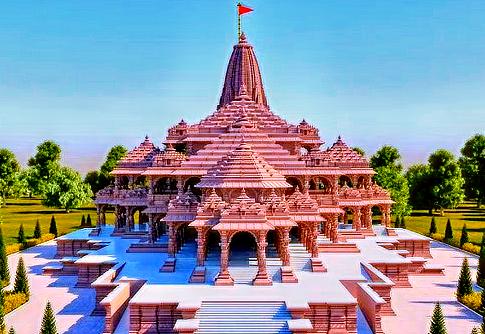
The Ayodhya Ram Mandir opening ceremony
The Ayodhya Ram Mandir opening ceremony marked a historic moment on January 22 2024 with Prime Minister Narendra Modi inaugurating the temple. The event preceded by preparations starting on January 14 witnessed elaborate rituals and festivities. The main sanctum featuring a grand design by architect Chandrakant Sompura was inaugurated signifying the culmination of a long-awaited dream for millions of devotees. The ceremony included cultural performances, prayers and the presence of various dignitaries, making it a significant and joyous occasion for the nation. The Ayodhya Ram Mandir stands as a symbol of cultural and religious heritage embraced by people across India.

Timeline of Events: Ram Mandir Inauguration and Celebrations in Ayodhya
| Date | Event Description |
|---|---|
| January 16, 2024 | Initiation of Vedic rituals for Lord Rama’s idol consecration at Ram Mandir. Sanctum purification with Sarayu River water and deity invitations. |
| January 17, 2024 | Construction of three idols of Lord Rama, including a 51-inch idol for the sanctum. The existing idol of Rama remains in the sanctum. |
| January 22, 2024 | Grand consecration ceremony of Lord Rama with the presence of Prime Minister Narendra Modi amid Vedic chants. |
| January 23-26, 2024 | Devotees can have darshan (sacred viewing) of Lord Rama. |
| January 26, 2024 | Nationwide invitation for darshan. |
| April 9-17, 2024 | Nine-day celebration of Ram Janmotsav featuring presentations by 2,000 artists worldwide with events including Ram Katha and bhajan kirtan. |
| July and August 2024 | Swinging Festival in Ayodhya during the month of Sawan with various special programs. |
| October 2024 | Special arrangements for the Panchkosi, Chaudah Kosi and 84 Kosi Parikrama during the Kartik month. |
Architectural Features and Design of the Ram Mandir in Ayodhya
The Ram Mandir’s initial design, created by the Somapura family in 1988 in Ahmedabad underwent modifications in 2020 when the construction began. The temple planned to be 235 feet wide, 360 feet long and 161 feet tall follows the Nagar style of Indian archaeological architecture. The main architects, Chandra Kant Somapura and his sons Nikhil and Ashish have designed various facilities within the temple complex, including prayer rooms, educational spaces, residences, a museum and a cafeteria. The construction is not only focused on the temple but also encompasses these accompanying structures. Once completed, the Ram Mandir in Ayodhya is anticipated to be the world’s third-largest Hindu temple.”

Foundation Stone Laying Ceremony for Shri Ram Janmabhoomi Mandir
The foundation stone laying ceremony for the Shri Ram Janmabhoomi Mandir occurred on August 5, 2020 with Prime Minister Narendra Modi overseeing the event. The Prime Minister placed a silver brick as the cornerstone during the ceremony. Prior to this priests conducted a three-day Vedic ritual at the Ram Janmabhoomi site, involving the worship of Lord Rama and the invocation of major deities to bless the foundation ceremony. Sacred soil and water from various religious sites in India, including Sharda Peeth in Pakistan, were used. Additionally, water from the Ganga, Sindhu, Yamuna, Saraswati and Kaveri rivers was consecrated. The sacred occasion featured the lighting of over 7,000 lamps in temples across Ayodhya.
Architectural Highlights of the Expanded Ram Mandir: Design, Dimensions and Materials
The temple’s size will be three times larger than the current structure. The sanctum sanctorum will have an octagonal shape, while the overall structure will be circular. The sanctum sanctorum is being constructed with Makrana marble. The temple will stand at a height of 161 feet, featuring five domes and a tower. It will be a three-story structure, designed in such a way that the rays of the sun directly fall on the deity Ram Lalla, who represents Lord Shri Rama in his childhood form. The home chamber and the mandapa in the temple will be fully covered, while the kirtan mandapa, dance mandapa, color mandapa, and two prayer mandapas will remain open.
All doors and windows in the temple will be made of sagwan (teak) wood, allowing complete ventilation. Teak wood is known for its strength and durability, with a lifespan of around 100 years. This wood has been sourced from Chandrapur in Maharashtra and other locations.
Idols of Lord Rama: Sacred Shaligrams from Nepal Enshrined in the Shri Ram Mandir
In the upcoming Shri Ram Mandir two idols of Lord Rama will be placed. One is an existing idol discovered in 1949, which has been housed in a temporary shelter for many years. The second is a larger idol currently in the process of construction. To craft this new idol, two shaligrams, sacred stones were brought from the Kali Gandaki River banks in the Mustang district of Nepal. These ancient shaligrams are believed to be approximately 60 million years old with a combined weight of 26 tons and 14 tons.
Shaligrams from the Kali Gandaki River are highly revered in Hinduism, symbolizing Lord Vishnu and being worshipped in households. Champat Rai the General Secretary of the Shri Ram Janmabhoomi Teerth Kshetra Trust, suggested using these shaligrams to create idols of Lord Rama a proposal accepted by the Trust and the people of India. Champat Rai revealed that the temple will feature a statue portraying Lord Rama at the age of five based on the description in the Valmiki Ramayana.
Don’t Miss : 1. Unique Ram Mandir Opening Date
2. How to Reach Ayodhya by Road
3. Visit Official Website of Ram Mandir Trust : Sri Ram Janmbhoomi Teerth Kshetr Trust
FAQs:
-
What is the significance of the Ram Mandir in Ayodhya?
The Ram Mandir is considered a sacred pilgrimage site for millions of followers of Sanatan Dharma worldwide. Its construction in Ayodhya holds historical and cultural importance.
-
When is the inauguration of the Ram Mandir scheduled?
The inauguration of the Ram Mandir is set to take place on November 24, 2024 with Prime Minister Narendra Modi officiating the ceremony.
-
How many priests were selected for the Ram Mandir after the rigorous process?
After a series of tests, 20 priests, including Mohit Pandey from Lucknow were appointed to perform puja and archana in the grand Ram Mandir.
-
What is the role of the selected priests in the Ram Mandir?
The appointed priests will be responsible for performing puja and archana in the Ram Mandir. They will play a crucial role in the religious ceremonies and rituals.
-
How many priests applied for recruitment, and how were they shortlisted?
Approximately 3,000 priests applied for recruitment. Out of these, 200 were shortlisted based on merit for the interview round, as stated by a trust official.
-
Who participated in the selection process for the priests?
The selection panel included Sant Jaykant Mishra from Vrindavan and two mahants, Satyanarayan Das and Nandini Sharan from Ayodhya.
-
Tell us about Mohit Pandey, the selected priest.
Mohit Pandey, currently pursuing an MA (Acharya) course at Shri Venkateswara Vedic University, Tirupati was chosen through a rigorous selection process to become a priest at the Ayodhya Ram Mandir.
-
What is the duration of the training for the selected priests?
The selected priests, including Mohit Pandey, will undergo six months of mandatory training to enhance their skills and fulfill their responsibilities with precision and dedication.
-
How has the Ram Mandir Trust addressed the financial aspects for the priests?
The Ram Mandir Trust increased the salaries of the priests, with the chief priest now receiving Rs 32,900 and assistant priests getting Rs 31,000. This decision aims to provide better financial support to those serving in the temple.
-
Is there any educational support provided to the priests?
Yes, the trust has decided to provide priests with the opportunity to receive higher education and training through the Sri Ramnandanisya Diksha and Gurukul education system.
-
When did the Ayodhya Ram Mandir open?
The historic Ayodhya Ram Mandir opened on January 22, 2024.
-
Who inaugurated the Ayodhya Ram Mandir?
Prime Minister Narendra Modi inaugurated the Ayodhya Ram Mandir.
-
What marked the significance of the opening ceremony?
The opening ceremony marked a historic moment, symbolizing the culmination of a long-awaited dream for millions of devotees.
-
When did the preparations for the opening ceremony begin?
Preparations for the opening ceremony started on January 14, 2024.
-
What were the key features of the main sanctum?
The main sanctum showcased a grand design by architect Chandrakant Sompura.
-
What ceremonies and rituals were part of the opening event?
Elaborate rituals and festivities, including cultural performances and prayers, were part of the opening ceremony.
-
What made the Ayodhya Ram Mandir a symbol of cultural and religious heritage?
The Ayodhya Ram Mandir stands as a symbol of India’s cultural and religious heritage, embraced by people across the nation.
-
Who designed the grand structure of the Ayodhya Ram Mandir?
The grand design of the Ayodhya Ram Mandir was created by architect Chandrakant Sompura
-
What were the preparations leading up to the opening ceremony?
Preparations for the opening ceremony began on January 14, involving various activities to ensure a grand and joyous event.
-
Did the opening ceremony have the presence of dignitaries?
Yes, the opening ceremony included the presence of various dignitaries, adding to the significance of the occasion.